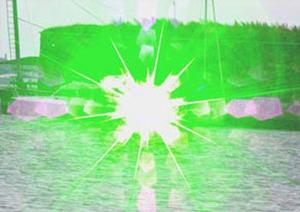High-seas piracyNew laser weapon dazzles, confuses pirates
There were 430 pirate attacks last year, an increase of 5.6 percent on the previous year; in a bid to develop a suitable non-lethal weapon to help fend off this threat, BAE Systems studied pirate behavior; the conclusion was that an automatic weapon was needed, one that would not put any of the crew at risk, and one which would distract suspected pirates rather than harm them

Pirate-eye view of the BAE system // Source: stowmasters.com
Marauding pirates could soon find themselves up against a new long-range laser weapon, designed to leave them blinded, dazed, and bewildered.
The laser will not necessarily repel determined aggressors, but it should let them know that they have been spotted while still at a distance and that their quarry is ready for them.
“This is very much a non-lethal weapon,” says Bryan Hore of BAE Systems in Farnborough, United Kingdom, where the system was developed. By taking into account the range of the target, as well as the atmospheric conditions, the system can automatically regulate the intensity of the laser beam to ensure there is no lasting eye damage, he says.
New Scientist reports that while the effects are not permanent, the light should leave pirates at least wishing they had worn an eye patch or two: from as far away as 1,500 meters the effect of looking at the beam is like accidentally looking at the sun, says Hore.
“Sunglasses wouldn’t help,” he says — in fact, wearing them would only exacerbate the effect. This is because the glasses would not affect the green laser light — chosen because that color is particularly irritating — but the laser would appear even brighter contrasted against the darkened background.
“It’s a warning shot,” says Hore. “[The pirates] are looking for targets of opportunity,” he says.
The meter-wide beam can target the entire vessel and its crew. “They tend to be 6-metre skiffs,” says Hore, so the beam can be scanned across the entire vessel. This would make it difficult for the attackers to target their weapons, which are usually AK-47 assault rifles and rocket-propelled grenades, he says.
According to antipiracy organization the International Maritime Bureau, there were 430 pirate attacks last year, an increase of 5.6 percent on the previous year. In a bid to develop a suitable non-lethal weapon to help fend off this threat, BAE Systems studied pirate behavior. The conclusion, says Hore, was that an automatic weapon was needed, one that would not put any of the crew at risk, and one which would distract suspected pirates rather than harm them.
The system has been field-tested from ranges of up to 1.2 kilometers, but using optical sensors rather than human subjects. If it gets backing for commercial development it could be made available in as little as a year, he says.
